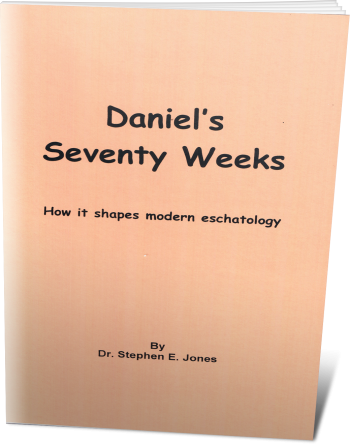Latest Posts
View the latest posts in an easy-to-read list format, with filtering options.

Most of modern prophecy teaching has as its foundation the 70th week of Daniel. Many teach that God stopped His "clock" and pushed the 70th week into the future in order to establish an "Age of Grace" for "Gentiles." It is often taught that the 70th week will begin with the Rapture, the rise of an Antichrist, the beginning of the Tribulation, and the fulfillment of most of the book of Revelation. All of these teachings are based upon an incorrect understanding of history. This book reconstructs the foundations of history and shows how prophecy teaching must be modified to fit the history.
Category - General

Jesus turned 30 years of age precisely in the middle of the 70th week of Daniel—that is, in September of 29 A.D. We know this because history tells us the dates of Daniel’s Seventy Weeks, and we know that the 70th week was from 26-33 A.D. Secondly, once we know that Jesus could have been born ONLY in 2 B.C., then He turned 30 in September of 29, the midst of the 70th Week.
If we let history itself interpret Scripture, rather than letting our theological biases force history to confess what we wish it to say, then we may learn the truth of the matter.
Dan. 9:26 and 27 says that “after sixty-two weeks the Messiah will be cut off.” This statement, if taken too literally, would mean that Jesus was crucified in 26 A.D., but very few would attempt to argue such an early date. Dan. 9:27 also says,
27 And He will make a firm covenant with the many for [or in] one week, but in the middle of the week He will put a stop to sacrifice and grain offering.
Dispensationalist Bible teachers confuse people by telling us that “he” refers not to Christ to but to an Antichrist that will arise at the end of the age. But there is no historical, grammatical, or even biblical reason to make this the Antichrist. Such a view is a total assumption, because the passage itself is speaking of the coming Messiah.
The fact is, Jesus was the Sacrifice, and, when presented, He put an end to the need for all other sacrifice.
Daniel’s 70th week was from 26-33 A.D. Jesus began His ministry in the midst of the week, September of 29 A.D. This is when He went to John for baptism, presenting Himself on the Day of Atonement to fulfill the law of Leviticus 16. In presenting Himself for ministry (and ultimately for Sacrifice), He “put a stop to sacrifice and grain offering” (Dan. 9:27) in the eyes of God. Of course, the Jews continued to sacrifice animals for another 40 years or more, but it is obvious that Daniel’s prophecy was not about Jewish practice, but about God’s viewpoint. If the prophecy could be fulfilled only by the cessation of sacrifice in the temple, then, of necessity, the 70th week would have to be dated 66-73.
There is hardly anyone who might argue for such a late fulfillment of Daniel’s prophecy, so we will not discuss it further.
Jesus presented Himself for baptism on the Day of Atonement in order to fulfill the law. The instructions for this day are given in Leviticus 16.
7 And he [the high priest] shall take the two goats and present them before the Lord at the doorway of the tent of meeting. 8 And Aaron shall cast lots for the two goats, one lot for Yahweh and the other lot for the scapegoat [lit. for Azazel, goat-god, the satyr, or the devil].
Jesus fulfilled both goats. The first was to be killed to atone for the sins of the people. Jesus went to the Jordan River and presented Himself to John as that goat “for Yahweh,” while the priests were killing the first goat in the temple in Jerusalem.
His baptism was His presentation to the Father as the first goat, destined to die at the cross. It was His LEGAL death, followed later by His ACTUAL death on the cross.
Immediately after His baptism, the Spirit led Him into the wilderness to be tried by the devil. This was happening even as the second goat was led into the wilderness “for Azazel.” We read of this in Lev. 16:21,
21 Then Aaron shall lay both of his hands on the head of the live goat and confess over it all the iniquities of the sons of Israel... and he shall lay them on the head of the goat and send it away into the wilderness by the hand of a man who stands in readiness.
This is the goat “for Azazel.” Azaz means a goat, and El means God. Thus, Azazel means “the goat-god,” and this name is used often in Hebrew literature to indicate a satyr, that is, a creature half-goat and half-man. The Greeks knew Azazel by the name of Pan.
Once we understand that Jesus was baptized on the Day of Atonement, then Matt. 4:1 makes sense:
1 Then Jesus was led up by the Spirit into the wilder-ness to be tempted by the devil.
The law gave instructions that a “fit man” (KJV) or “a man who stands in readiness” (NASB) should lead the second goat into the wilderness “for Azazel.” Matthew 4:1 shows us that Jesus was the fulfillment of that second goat and was led into the wilderness by the Spirit to be tempted by Azazel. This shows the meaning of the obscure phrase “for Azazel.” It is a reference to “the devil.”
In other words, Jesus fulfilled both goats on the Day of Atonement. He fulfilled the first goat by presenting Himself to die (by baptism), and the second goat by being led by the Spirit into the wilderness.
The temple priests were required to make two sacrifices each day throughout the year. They were the morning sacrifice and the evening sacrifice (also called “the hour of prayer” in Acts 3:1). The sacrificial blood was poured out under the altar, as prescribed in the law, to cover sin.
During the course of each year, sin was covered, and yet they accumulated until the sin was removed. The spiritual principle was enacted on a physical level each year on the Day of Atonement. The first goat covered sin—that is, made atonement for sin. The Hebrew word kaphar, “to cover,” does not mean “at-one-ment,” as some have suggested. It means “to cover.” In fact, we get our English word cover from the Hebrew word kaphar.
The purpose of the second goat was to remove sin. It was pictured by the goat being led into the wilderness to a place without inhabitants (Lev. 16:22). Though Jesus fulfilled both goats at the same time in the New Testament, the greater fulfillment is in the two comings of Christ. His first coming was His death work to cover sin. His second coming is a living work to remove sin.
For this reason, we as Christians are now imputed righteous, because the blood of Jesus Christ has covered our sin. God now “calls what is not as though it were” (Rom. 4:17). This makes us legally righteous. But it yet requires a second work of Christ to remove sin and make us intrinsically righteous.
The very fulfillment of the law’s prophecy shows us that Jesus was baptized on the Day of Atonement. And this day was also the historical middle of the 70th week of Daniel. Daniel 9:27 says that the Messiah would be “cut off” in the midst of the week. For many years I assumed that this meant that Jesus would die on the cross in the midst of the week. But the actual history shows that it was His legal death that actually occurred—his “death” by baptism.
There are two ways to “die.” The first death is physical, the result of our mortality. The second death is the daily life of denying the flesh, crucifying the “old man” and reckoning him “dead” (Romans 6). The first death is physical; the second is a legal death. When Jesus was baptized, it was His legal death in the same way that our own baptism is also the death of the old man.
For this reason, Daniel says that “in the middle of the week He will put a stop to sacrifice and grain offering.” Once the antitype has been presented to the Father, the types cease to be effective in the eyes of God. Once Jesus was baptized, the people were expected to receive Him as the True Sacrifice, and only His Sacrifice would suffice as payment for sin. He was indeed “the Lamb of God who takes away the sin of the world” (John 1:29), according to John’s witness.
This is what put an end to all other forms of sacrifice—not in the eyes of men, but in the eyes of God. In fact, as I said earlier, we know from plain history that the priests continued to offer sacrifices in the temple until it was destroyed in 70 A.D. So Daniel 9:27 cannot possibly refer to the actual cessation of all sacrifice in the midst of the week. It can only refer to the divine perspective and has nothing to do with the actual religious practice of the temple priests.